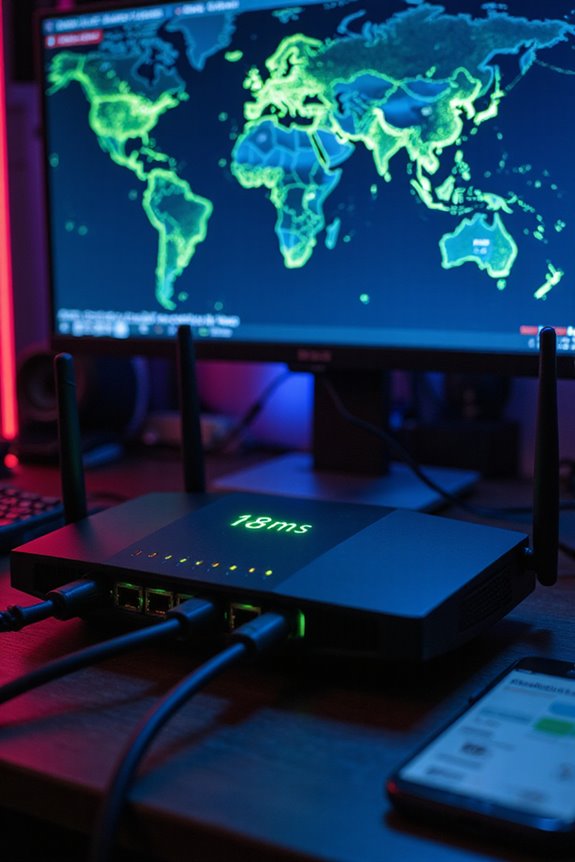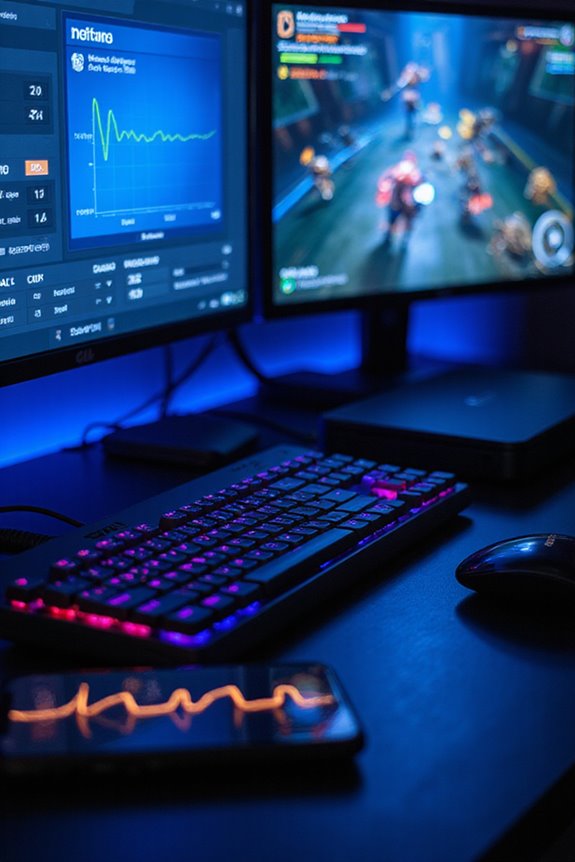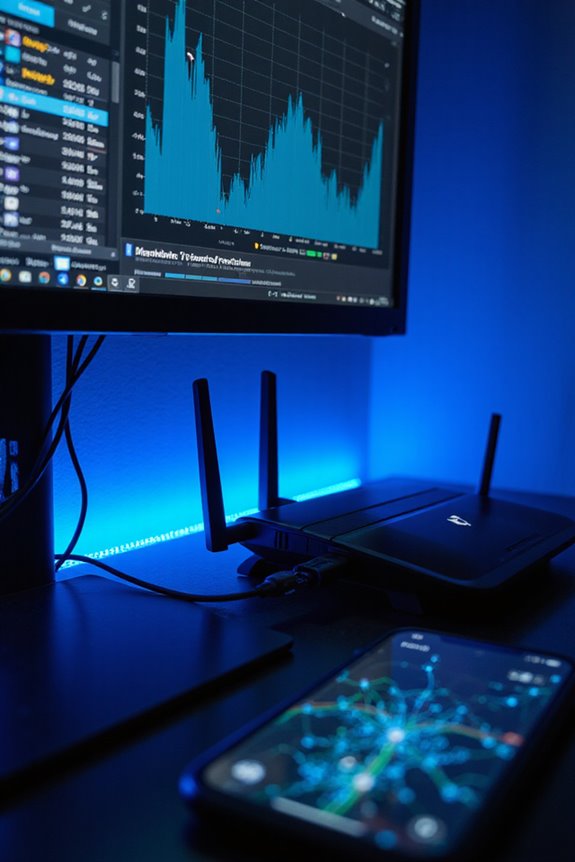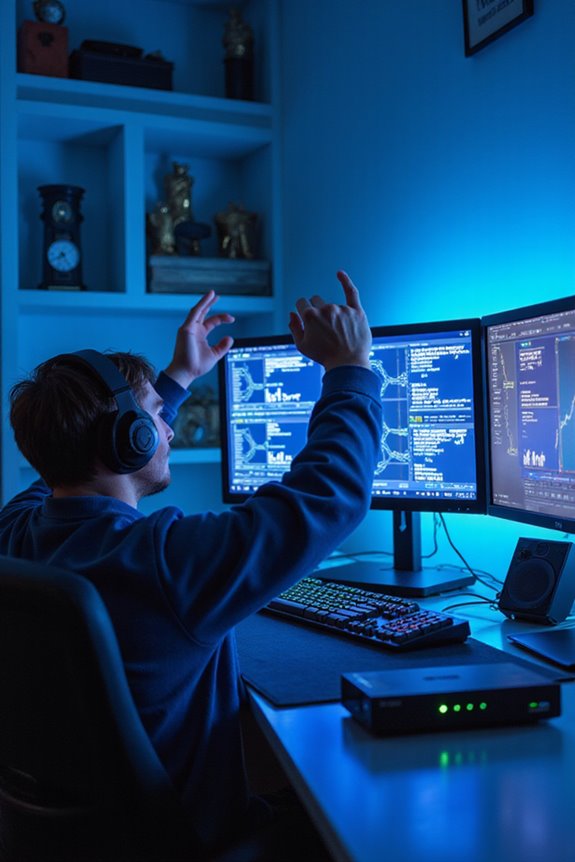Ping’s like the heartbeat of online gaming. It measures how quickly your device communicates with the game server, impacting lag and response time. A low ping under 20ms can give you an edge, while anything above 100ms can lead to frustrating delays. Things like geographical distance and network congestion can elevate your ping. To optimize this, make sure you’re on a wired connection and manage your network traffic wisely. There’s so much more to discover about improving your gaming setup.
Key Takeaways
- Ping measures the Round-Trip Time (RTT) for data to travel to a server and back, crucial for assessing network performance in gaming.
- Low ping (under 20ms) enhances gameplay by providing quicker response times, while high ping (over 100ms) causes noticeable lag.
- Factors influencing ping include geographical distance, internet connection type, network congestion, and server load, all impacting gaming performance.
- Strategies for optimizing ping involve using wired connections, closing background applications, updating drivers, and monitoring system resources.
- Staying informed about gaming trends and technology advancements can help players mitigate connectivity issues and enhance their overall gaming experience.
Understanding Ping: What It Is and Why It Matters
Ping is like a heartbeat for your network, providing essential insights into its performance. It’s a tool that tests connectivity, measuring the distance between devices using the Internet Control Message Protocol (ICMP). When I send an ICMP Echo Request, I’m checking if a host is reachable; it’s like asking, “Are you there?” The target responds with an Echo Reply, and I gauge the Round-Trip Time (RTT) in milliseconds. This quick check is vital for diagnosing connectivity issues and latency problems. While it’s a powerful tool, it’s not without limitations, like processing delays. Still, it gives me a clear picture of network health, making it invaluable in troubleshooting and ensuring smooth communication across devices.
The Impact of Ping on Gaming Performance

When it comes to online gaming, the time it takes for data to travel to and from servers can make or break your experience. Low ping, ideally under 20ms, gives you a competitive edge, providing quicker response times that are essential in fast-paced genres like FPS and MOBA. It enhances gameplay flow, keeping you in sync with the action, while high ping, anything above 100ms, leads to frustrating lag and sluggish movements. I’ve felt the difference—when lag hits, missed shots and delayed actions can ruin a match. So, whether you’re casually gaming or aiming for the top, understanding ping’s impact is critical. A smooth experience can turn a good game into a great one.
Key Factors That Influence Ping Levels

In online gaming, several key factors can influence ping levels, often making the difference between a smooth experience and frustrating lag. Geographical distance plays a big role; the farther you are from the server, the higher your ping. Your internet connection type matters too—fiber optic is the fastest, while DSL can be slower and increase your ping.
Network congestion is another villain. When too many users are online, data gets delayed. Server load can also spike ping if too many players connect at once. Plus, don’t forget your hardware; outdated network cards or background applications can hog bandwidth. By understanding these factors, you can make informed choices to optimize your gaming experience and enjoy less lag.
Latency vs. Ping: Clarifying the Difference

Understanding the difference between ping and latency can greatly enhance your gaming experience. Ping is all about that round-trip time, measuring how long it takes for data to travel to a server and back to your device. On the other hand, latency includes all delays in data transmission, like network congestion and device processing time. Both are measured in milliseconds, so lower values mean a snappier response while higher values lead to lag. It’s essential to know that while ping focuses on the connection’s speed, latency covers everything that can slow it down. So, whether you’re battling in a fast-paced shooter or exploring a massive world, keeping an eye on both can make a world of difference.
Strategies for Optimizing Your Ping

Optimizing your ping is crucial if you want to enjoy a smooth gaming experience, especially in competitive scenarios. Start by using a wired Ethernet connection; it’s typically more stable and delivers lower latency than Wi-Fi. I’ve found that closing background applications can really help too—fewer resources consumed means better performance. Regularly updating your network drivers guarantees everything runs smoothly, while evaluating your ISP and router settings can also make a noticeable difference.
Don’t forget about game mode activation on your device; it prioritizes resources for gaming, which can reduce latency. Finally, keeping an eye on your system’s resource usage helps you spot any potential bottlenecks that might affect your ping. Every little tweak counts!
The Role of Server Location in Ping Rates
When it comes to ping rates, server location plays a pivotal role that can’t be overlooked. The closer a server is to you, the lower your latency, which means faster response times in-game. Imagine battling it out without the frustration of lag—having servers in key locations like major internet hubs can make a real difference.
For global gamers, using CDNs helps minimize latency by delivering content from nearby servers. This not only enhances your gaming experience but also guarantees smoother gameplay. However, even with ideal server placement, factors like network congestion can still impact your ping. So, while you can’t control everything, choosing games with well-placed servers can give you the edge you’re looking for.
How Network Traffic Affects Your Gaming Experience
Server location might set the stage for your gaming performance, but network traffic takes center stage in how smoothly you can play. When there’s a lot of traffic, latency can skyrocket, causing frustrating delays. I’ve noticed that without sufficient bandwidth, the game can lag, and packet loss? That’s a total buzzkill, leading to disconnections right when I’m in the zone.
During peak hours, congestion can really impact my experience, making every shot feel like it’s on a delay. The emotional rollercoaster of gaming is real, and poor network quality can turn excitement into frustration. In a world where online gaming demands real-time data, managing traffic effectively is essential for maintaining a satisfying experience. So, let’s keep that connection strong!
Advanced Technologies to Manage Ping and Latency
To truly elevate your gaming experience, leveraging advanced technologies that manage ping and latency is essential. Consider using G-Sync and Nvidia Reflex; they can drastically reduce input delay, making your gameplay feel smoother. Edge computing is another game-changer, processing data closer to you, which cuts down on travel time.
I’ve found that custom VPNs, like ExitLag, optimize your connection routes and minimize lag spikes. Plus, ultra-low lag internet services from providers like Xfinity cater specifically to gamers. Don’t forget about VoIP solutions, which can offer sub-50ms latency for clear communication. These technologies work together, refining your gaming sessions and keeping frustrations at bay. After all, every millisecond counts in the heat of battle!
The Importance of Jitter in Online Gaming
Jitter plays an essential role in online gaming, as it directly affects how smoothly gameplay unfolds. High jitter can lead to frustrating delays or stuttering, making your character feel like they’re teleporting instead of moving fluidly. Ideally, keeping jitter below 20 ms is vital for competitive gaming, while 20-50 ms is generally acceptable for casual play.
Factors like network congestion, outdated hardware, and multiple devices can exacerbate jitter issues. A wired connection often minimizes these problems, providing a more stable experience. By prioritizing your gaming traffic through Quality of Service settings, you can guarantee a consistent data flow. Ultimately, understanding and managing jitter can greatly enhance your gaming experience, making every match a little more enjoyable.
Future Trends in Ping Optimization for Gamers
As online gaming continues to evolve, the quest for lower ping and smoother experiences remains a top priority for gamers. With advancements like 5G networks, we’re seeing reduced latency and faster speeds, which is a game-changer. Cloud gaming is also growing, allowing us to access high-quality experiences without expensive hardware.
I’m particularly excited about AI-driven solutions that can predict network issues in real-time, making our gameplay even more seamless. Plus, optimizing network settings, like QoS, can greatly enhance performance. As cross-platform play becomes the norm, we’ll likely see even fewer connectivity issues. It’s thrilling to think how these trends will shape our gaming future, but we still need to stay savvy about our setups to make the most of these advancements.
Frequently Asked Questions
How Can I Check My Current Ping Rate?
To check my current ping rate, I often use online tools or my game’s built-in options. It’s quick and easy, giving me a clear picture of my connection’s performance right away.
What Is Considered a High Ping for Gaming?
When I think about high ping, it’s like running through molasses—anything over 150 ms can really trip me up. It makes the game feel sluggish, robbing the thrill from each moment I play.
Does Using Wi-Fi Affect My Ping?
Absolutely, using Wi-Fi can affect your ping. I’ve noticed that distance from the router and interference can really slow things down. If you want consistent performance, a wired connection’s often the better choice.
Can Ping Vary During Different Times of the Day?
Imagine a bustling highway during rush hour; that’s my internet during peak times. Yes, ping can vary throughout the day. I’ve noticed those evening spikes really affect my gaming experience—it’s frustrating, isn’t it?
Are There Tools to Improve Ping in Games?
I’ve found tools like NoPing and LagoFast can really help improve ping in games. They optimize connections effortlessly, making my gaming experience smoother. You should definitely give them a try if you’re struggling!





